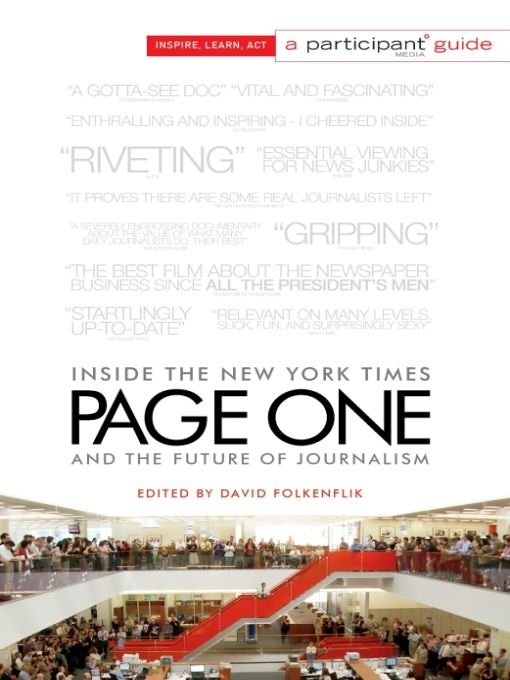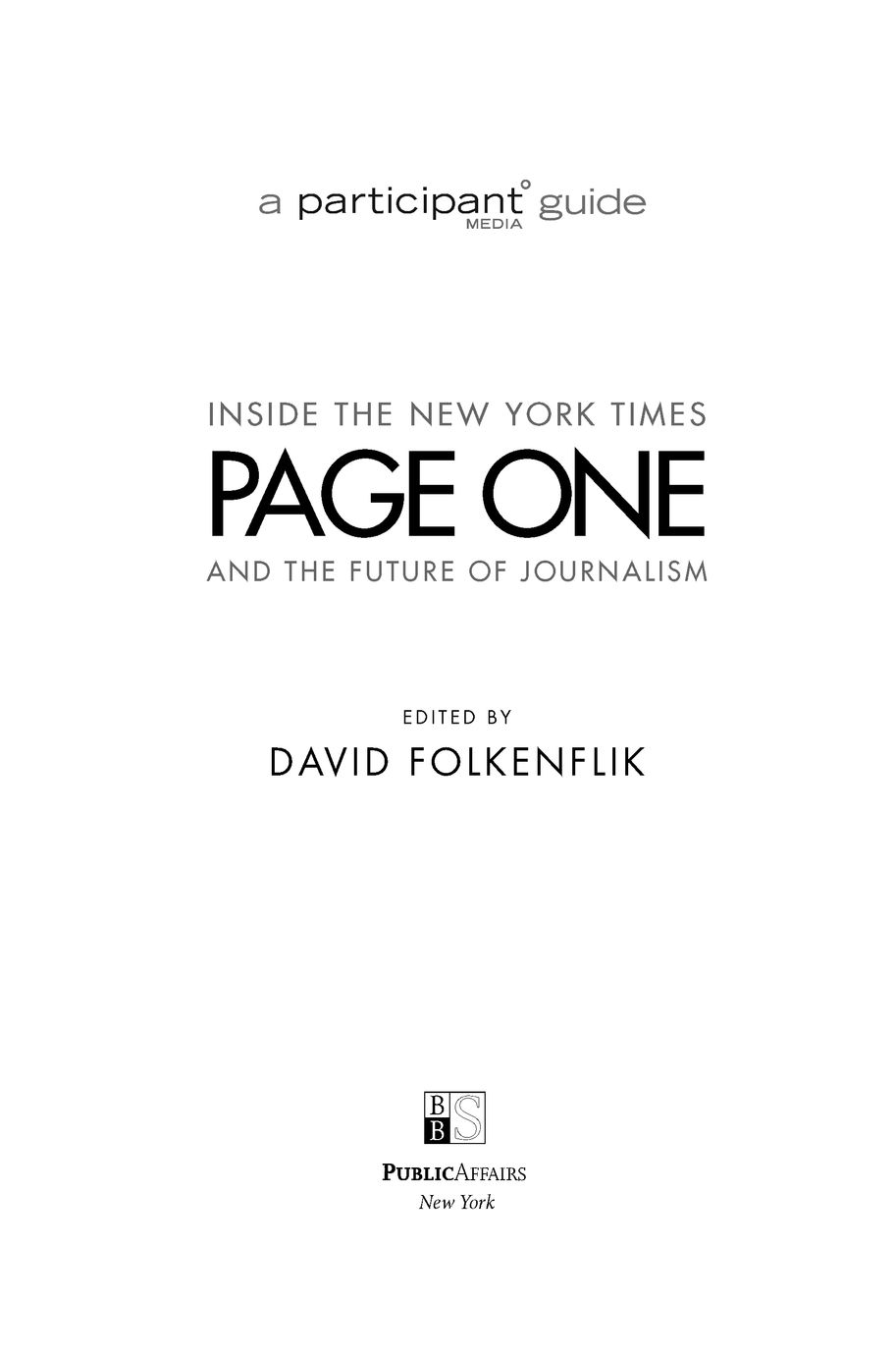Table of Contents
Also in Collaboration with Participant Media:
Food, Inc.
Oceans
Cane Toads
Waiting for Superman
MAGNOLIA PICTURES, PARTICIPANT MEDIA, and HISTORY FILMS
present
A FILM BY ANDREW ROSSI
PAGE ONE:
INSIDE THE NEW YORK TIMES
DIRECTED BY
Andrew Rossi
PRODUCED & WRITTEN BY
Kate Novack and Andrew Rossi
PRODUCERS
Josh Braun, David Hand, Alan Oxman,
Adam Schlesinger
EXECUTIVE PRODUCERS
Daniel Stern, Daniel Pine
ASSOCIATE PRODUCERS
Keith Hamlin, Luke Henry
INTRODUCTION
In 2007, The New York Times moved into a soaring modern glass tower sheathed in heat-sensitive ceramic tubes on the west side of midtown Manhattan. The building stands a couple of blocks from the tangle of avenues and streets that was called a square and was named for the paper more than a century before. The papers old newsroom, despite the elegance of its Gallic facade, was a romanticized warren of cluttered desks, narrow hallways and stained carpets.
At the new headquarters, technological and environmental advances aboundautomatically controlling, for example, the level of the window shades shielding cubicles from bright sunlight streaming in from the west.
In the lobby, dozens of small vacuum tube screens project snippets of articles culled from the papers archives by an algorithm designed by an artist and a statistician. The phrases wash over the screens and then skitter away, to be replaced by a new batch. The exhibit is called Moveable Type, an inventive homage to the papers traditions.
The airy new headquarters represents the twin concepts of transparency and light. The building wasand isintended as a statement. The Times was shedding its skin as an old-line newspaper company and proclaiming itself a confident, even a defining, player on the modern media stage.
Within two years, however, amid shifts in the news industry and a collapsing economy, the Times Company appeared to be listing, not towering. Its parent companys debt was valued as junk by the credit rating agency Standard & Poors. So the company borrowed $250 million from Mexican billionaire and telecommunications magnate Carlos Slim Hel. The Times Company also entered into a so-called sale-leaseback agreementit sold its share of the brand-new building for $225 million, paying its new landlord for occupying its floors. It retains the right to buy back the property in 2019 for $250 million.
All of this would have been just one more item of corporate consternation during an economic downturn were The Times itself not a key part of an industry that, on its better days, makes a credible case that it is indispensable to the functioning of democracy in the United States.
In recent years the paper has revealed a massive wiretapping program conducted by the federal government; has documented the unraveling of the subprime mortgage market; and, despite claims by some critics that it fails to hold local or liberal politicians accountable, has doggedly reported scandals involving New Yorks two most recent governors and its most powerful congressmanall Democrats.
It has also embraced the new forms of journalism allowed by new technologies, adding audio, visual and graphic forms of storytelling that have only enhanced the richness of its online report.
Yet increasingly, news coverage is being treated as a commodityanother information stream that can course through any number of channels. At the same time as fewer people are willing to pay for the print edition of The Times and other papers, online readers have not proved willing to pay significant sums to read general-interest news online. Advertisers refuse to pay more than pennies on the dollar to reach digital readers compared to what they pay for print ad rates.
In March 2011, the Times Company responded by charging frequent readers of articles and features on The Times Web site or on other digital devices, such as the iPad. The cost of journalism has to be borne, publisher Arthur Sulzberger Jr. said.
In so doing, The New York Times was seeking to remain the leading American exemplar of that peculiar hybrid of commercial enterprise and public service. The deep recession notwithstanding, the papers journalists periodically still risked legal penalties, their readers goodwill and, at times, their own safety. Times reporter David Rohde was held captive for seven months by the Taliban in Afghanistan and Pakistan. Photographer Joao Silva lost two legs after stepping on a landmine in Kandahar province. Several Times journalists were held for days, beaten and assaulted by Libyan authorities during the uprising there early in 2011.
The Timess problem, shared by battered news organizations serving communities large and small across the country, is the unraveling of the decades-long marriage that knit significant profits to service for the public good.
In early 2009, I undertook a thought experiment: What would happen to a city if its primary news source simply went away? I visited Hartford, Connecticut, on a bitterly cold winter morning amid the depths of the current financial crisis. Hartford made sense because it was a poor city in a rich state, the seat of state government and the home of three of the nations largest corporations.
The Hartford Courant, the dominant local daily, is Americas oldest continuously published newspaper, since its founding as a weekly in 1764. By 2009 it had suffered rounds of debilitating layoffs. The Courant was owned by the bankrupt Tribune Company. Although it was in no immediate threat of shutting down, the thought sent shivers down the collective spine of many people there. Even a bad review is important to us, frankly, said Julie Stapf, marketing director of the respected Hartford Stage, because it still brings awareness to the community about what were doing here at the theater.
Over at the State House, an experienced local television reporter said no other outlet generated as much news as the Courant, even in its diminished state. Mark Pazniokas, the Courants senior political reporter, warned that the loss of the paper would mean the loss of a sense of shared belonging for people there. If everybody is looking at dozens or hundreds of different news sources, Pazniokas told me, you dont have the common point of reference thatnot to be corny[is] an important part of democracy and community.
As I wandered around the press room at the State House, mail was piled high on what was marked as the desk of The New York Times. The Times had abandoned its daily coverage of Connecticut state politics the year before.
A new generation of national news powers has emerged. Some cover specific niches: ESPN for sports, Politico for horse race politics, Fox News and MSNBC for ideologically driven talk shows leavened with some news coverage, Bloomberg largely for business and finance developments (though its general news coverage is impressive).
Others are either relatively new or newly consequential players on the American media scene, such as the BBC, The Economist, The Guardian, The Huffington Post and The Week.
Under its new controlling owner, Rupert Murdoch, The Wall Street Journal has altered its focus and mix of stories to challenge The Timess title as the nations leading general-interest paper instead of remaining the nations preeminent financial publication. NPR News, for all its stumbles, has enjoyed years of growth in the scope and depth of its reporting reach and the size of its audiences.






